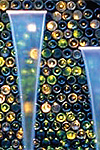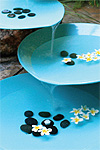
Water features for the home have taken off for the same reason so many of us love to go to the ocean. Whether from a multi-tiered fountain or a crashing waterfall, you can see and hear the water, but you can also feel it and smell it. And that’s as refreshing at home as it is on your beach vacation.
A well-designed, well-placed water element can offer a cooling, calming effect in this hot desert. Every day homeowners and developers are working out ways to involve this natural element. “A water feature can welcome you into a home with a fountain, relax you in a courtyard with a pond, or excite you in a backyard with a waterfall,” says Scott Cohen of Green Scene Landscape. “They add audible stimulation and can subtly effect your emotions and feelings about a place, both good and bad.” Of course, “a too noisy water feature can aggravate you.” Choosing a water feature involves choices in size, placement, ease of care, and audible volume. Some offer controls that function similar to a dimmer switch and allow you to adjust the water’s ebb and flow.
Water features cannot only enhance the strengths of a home, but they also can assist in tempering its weak points. “Lots of people who live in a noisy place or on a busy road want a water feature to help mask the noise,” says Paul Hendershot, owner of Paul Hendershot Design. “Other people just like them. Which is great — unless they don’t complement the surrounding area. When designing a fountain, we always begin with the style of the house and garden. Then we begin to personalize it from that point.” Personalizing can range from rearranging the surrounding furniture and adding some complementary foliage to an all-out construction zone overhaul that will fully integrate the feature for maximum impact. A skilled landscape architect will take the job from planning a smart layout to installing the water feature and the right landscape to complement it.
 Featuring Water
Featuring Water
Working water into and around your home can extend well beyond a pool or spa. Take a look at some of the more popular ideas on these pages to see how easy — and gorgeous — it can be to implement them.
Outdoor Showers
If your home lacks a built-in outdoor shower, it’s easy to add a freestanding one on your patio. Plenty of models attach to the end of a regular garden hose for an easy rinse-off before or after swimming. For a proper shower in the great outdoors, you can rework an indoor shower on an exterior wall to include an outdoor component. Or choose an unused portion of your side yard, for example, and design an outdoor model for those carefree mornings when showering indoors feels too restrictive. Remember to consider the sight lines from neighboring homes before you soap up.
Fountains and Waterfalls
A spa that pours into a pool with a waterfall adds that sight-and-sound component that also saves on space. Poolside fountains with water that sprays into the pool offer a whimsical visual, and children love to play in them.
But move a water feature away from a pool and spa and you have a more unexpected placement that instantly stimulates the senses. Popular in courtyards and entryways, fountains of all styles can enhance the environment and create places where you’ll want to linger and relax.
“I wanted to do something exciting for the owner’s contemporary entryway. There’s nothing more exciting than movement — and that means water,” says designer Randall McIlvain. “Any kind of water as you walk in makes a first impression. If there’s excitement outside, it means there will be excitement inside as well.”
Hendershot brings up a good point about shopping for that perfect fountain: “It might be more affordable to custom-design your own and get what you really want than buy one retail, especially when you’re looking at one in the $5,000 to $10,000 range.” Custom fountains and waterfalls will fit the space and be tailored to your ideals, as well as the style of your home.
Water can be a wonderful element indoors as well. A number of midcentury homes have enclosed atriums and wide entryways that incorporate a fountain, waterfall, or small pond to create a niche of tranquility.
Lakes, Ponds, and Moats
In the Coachella Valley, you’ll find multimillion-dollar homes with Vegas-style water shows poolside that are timed to lights and music. Water jumps up through the ground, into the pool, and all around the deck, dazzling onlookers.
Mostly, however, water is equated with a Zen-like serenity, making Buddha a popular element for peaceful water features. An Asian design scheme pervades many water setups and can be designed to complement a number of home styles. Gardens with small lakes or winding streams might incorporate a Japanese-style footbridge or be lined with temple lanterns. Traditional Chinese gardens are designed with meandering pathways and stopping points that encourage strollers to pause for reflection.
Philip Brent and Bruce Moccia enjoy an Asian-inspired entryway (see pages 34-35) that they designed in front of their midcentury home. The walkway leads over a pond that is actually a shallow pool. The bottom is Pebble Tec, and it is filled with the same filtered water that is in their backyard pool. The owners say they sit in it with a drink to cool off when it’s hot outside.
 Evaporation
Evaporation
The lowering water level in a water feature is an issue in every climate, not only in the arid desert. Hendershot says it’s a good idea to have an automatic fill on your water feature, and to put it on a timer to prevent it drying out. The upside of the E word is that “evaporation helps to cool an area by as much as 15 degrees,” Cohen says. “The more water action, the more splash and the more evaporation that takes place.” He says adding a drip tube from your sprinkler system will help refill your feature with fresh water.
Maintenance
All water features require maintenance to keep them clean, clear, and smelling good — but most are fairly simple to maintain. A typical moderate-sized fountain, for example, requires the same tools as a pool: a net to remove leaves and debris carried on the wind and a splash of chlorine from time to time. Hendershot’s pottery fountain on the facing page, for instance, calls for just a half-cup of chlorine weekly to keep algae at bay. Most people leave water-feature maintenance to their pool tender or their gardener, but little expertise is required if you want to maintain it yourself. (Indoor fountains may not even need chlorine. Check with the manufacturer to be sure.) Naturally, better pumps and filtration systems will last longer and require less maintenance.
The longer you run the fountain, the better it is for the fountain and its pump, believe it or not. “It’s like a car,” Hendershot says, encouraging clients to run their fountain from about 7 a.m. to midnight while they’re in town. For part-timers, he suggests an automatic fill on the fountain and a gardener who will maintain it and let it run from time to time.
Cohen says that while pumps are of higher quality and are more economical today than they were years ago, a mega-sized feature can “still use up the juice” when it comes to the cost of electricity to run it. Generally, the bigger the feature the more costly it will be to run. A feature the size of a small pool can rival it in electricity and caretaking costs — even if no one is planning to take a dip.
 Getting Started
Getting Started
If you’re set on a water feature, you’ll need to design around it. It often looks best to make it the focal point of your environment without too much else around it competing for attention. Cohen suggests considering the goals for the feature, the space you can devote to it, and whether you’ll also need custom elements like tile work and landscaping. “Combining fire features with water features is one of the biggest trends in outdoor design right now,” he says. A professional can help design a layout that combines water, fire, plants, a pool and spa, a barbecue, gazebo, cabana, pergola, bar, living and dining areas, or any other element — all of which will harmonize with the style of your home.
That’s because even a beautifully extravagant water feature can easily look slipshod when randomly placed in a pre-existing area without a designer’s eye to oversee the big picture. A new tool that might aid in your design process is the new Web site, www.fetch-a-sketch.com. The site is filled with design ideas for back yards, pools, spas, waterfalls, and more. For a small fee, you can download the plans and share them with your contractor to create a clear picture of the look you want.
Before you race your idea to your nearest landscape architect, however, you better consult with your backyard companion. Cohen says men and women tend to differ on their vision of the ideal water feature. “When women think ‘waterfall,’ they see a gurgling stream with a soothing sound and a peaceful setting that would attract hummingbirds and dragonflies,” Cohen says. “Men picture something more like Niagara Falls, with lots of boulders and crashing water.” His firm resolves it this way: “If one wants a gushing waterfall and the other a relaxing trickle, we can provide a secondary pump. That way they can have it both ways — calm and relaxing or wild Niagara.” Cohen says an environment with a water feature should be a place where all parties can feel great about the space, no matter what they’re preference. “We want to keep harmony in the relationship as well as in the garden.”

